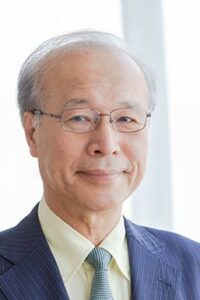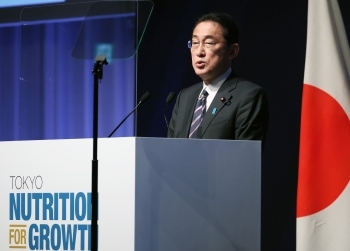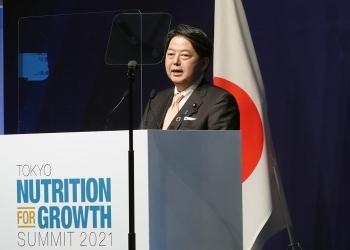Tokyo Nutrition for Growth Summit 2021: Solving World Hunger and Obesity
One in ten people in the world suffer from hunger and malnutrition, while one in three people have excessive nutritional intake or are obese. To overcome this polarized situation, the experience of modern Japan is being presented and shared with the world as “nutrition policy.” This article considers Japan’s new international contributions from the perspective of nutritional science.
Nakamura Teiji, President, the Japan Dietetic Association

President Nakamura Teiji
In the mid-18th century, since humans suffer harm and sometimes even lose their lives from starvation and unbalanced diets, European scientists thought that there must surely be special ingredients in food that determine life and health. Nutritional science is the scientific development of these ideas. Scientists discovered the components of food that are the energy source of life and compose the human body, and which are related to metabolism, and named these nutrients.
Meanwhile, foods containing these nutrients, and rationally-devised methods of consuming these foods, made it possible to prevent and treat nutritional deficiency diseases that were previously considered incurable. This led to the clarification through nutritional science of the relationship between daily diet and health or illness. Nutrition has contributed to the maintenance and improvement of people’s health, the prevention of disease, treatments, and also longevity.
The power of nutrition to make people healthy and happy
At the turn of the 20th century, nutrition came to a major turning point. This was because it had become clear that nutrition was not just linked to human health, but also affected various other spheres, including education, labor, economy, welfare, and even the environment. It was realized that solving malnutrition could contribute to human happiness and a reduced burden on the global environment. There has also been more active discussion of nutrition at international conferences.
Because of this, momentum has built for reform of a world in which the wealth of developed nations has come at the expense of developing nations, and malnutrition has come to be addressed as a specific issue. Such summits and conferences have included the United Nations Conference on the Human Environment (Stockholm Conference) in 1972, the Special Session of the United Nations General Assembly (Nairobi Conference) in 1982, the United Nations Conference on Environment and Development (Rio de Janeiro Earth Summit) in 1992, and the World Summit on Sustainable Development (Johannesburg Summit) in 2002. Nutrition has become a key issue among the Sustainable Development Goals (SDGs) adopted by the UN General Assembly in 2015.
Against such a backdrop, it was on the final day of the 2012 London Olympics that the then British Prime Minister David Cameron called for a summit to try and solve hunger. The first “Nutrition Summit,” the 2013 Nutrition for Growth Summit, was held in London the following year. This Nutrition Summit made it clear that solving malnutrition is vital to human progress. The preface to the 2014 Global Nutrition Report, a report based on the contents of the summit, states the principle that “Good nutrition is the bedrock of human well-being.” (See box below.) The report showed that nutrition is not only related to health, but also to such things as education, labor, and poverty, and this principle was incorporated into the SDGs. In short, without solving malnutrition, it will be difficult to achieve many SDG numerical targets. That is the significance of the Nutrition for Growth Summit.
The following is excerpted from the 2014 Global Nutrition Report:
Good nutrition is the bedrock of human well-being. Before birth and throughout infancy, good nutrition allows brain functioning to evolve without impairment and immune systems to develop more robustly. For young children, good nutrition status averts death and equips the body to grow and develop to its full potential. Over the course of the human lifespan, it leads to more effective learning at school, better-nourished mothers who give birth to better-nourished children, and adults who are likelier to be productive and earn higher wages. In middle age, it gives people metabolisms that are better prepared to ward off the diseases associated with changes in diet and physical activity. Without good nutrition, people’s lives and livelihoods are built on quicksand.
Unfortunately, there are still many people around the world in the situation described here.
An Overview of the Tokyo Nutrition for Growth Summit 2021
 Prime Minister Kishida delivering an opening speech at the Tokyo Nutrition for Growth (N4G) Summit 2021 |
 Foreign Minister Hayashi making a welcome speech at the Tokyo Nutrition for Growth (N4G) Summit 2021 |
The Tokyo Nutrition for Growth Summit 2021 (hereinafter Tokyo Nutrition Summit) was the third meeting of the Nutrition Summit. It was hosted by the Japanese government on December 7 and 8, 2021. While discussion at the previous two Nutrition Summits, in London in 2013 and Rio in 2016, centered on hunger and nutrition, the Tokyo Nutrition Summit for the first time took up the “double burden of malnutrition” issue; i.e., undernutrition and overnutrition.
Today, one in ten people in the world suffer from hunger and undernutrition, yet one in three people are overnourished or obese. This “double burden of malnutrition”—the simultaneous development of growth-hindering undernutrition and overnutrition that causes lifestyle-related diseases—is a problem for the entire world. What’s more, the lower household incomes and disruption to nutrition and provision of health services caused by the COVID-19 pandemic have made it difficult to obtain healthy and affordable food and worsened the global nutrition situation.
With this situation in mind, discussions at the Tokyo Nutrition Summit focused on five themes: (1) Health, (2) Food, (3) Resilience, (4) Accountability, and (5) Financing
During the high-level session on the first day (December 7), Prime Minister Kishida Fumio explained Japan’s nutrition-related efforts and announced more than 300 billion yen ($2.8 billion) in nutrition-related aid over the next three years to help achieve Universal Health Coverage (UHC) and other goals. Foreign Minister Hayashi Yoshimasa said that the Nutrition Summit would focus on (1) Nutrition and UHC, (2) safe, sustainable, and healthy food systems, (3) measures against malnutrition in vulnerable contexts, (4) data-driven accountability, and (5) financing for nutrition. He also stated the need for all stakeholders, including governments in both developed and developing countries, private companies, civil society, and academia to work as one to address these vital issues.
A wide range of stakeholders presented their commitments (policy and financial), with more than 50 people describing their work toward improving nutrition. These included national leaders and cabinet-level officials from about 30 countries, such as President Félix Tshisekedi of the Democratic Republic of Congo and Prime Minister Sheikh Hasina of the People’s Republic of Bangladesh, as well as heads of international organizations, such as UN Secretary-General António Guterres, World Bank President David Malpass and World Health Organization Director-General Tedros Adhanom Ghebreyesus, and a representative of the Bill & Melinda Gates Foundation.
The thematic sessions on day two (December 8) included panel discussions on the three themes of health, food, and resilience, attended by a wide range of stakeholders. Accountability and securing funds were also discussed as perspectives that cut across the first three themes. Initiatives by Japanese ministries and agencies can be viewed on their websites.
An outcome document, the Tokyo Compact on Global Nutrition for Growth, was put together then endorsed by 215 stakeholders, including 60 private companies from 65 countries. Ultimately, 181 stakeholders from 66 countries, including 26 private companies, also submitted 396 commitments and pledged more than $27 billion in nutrition-related funding. These outcomes went well beyond previous Nutrition Summits, and participants thanked the Japanese government for its international leadership in the face of the ongoing COVID-19 pandemic.
More than 120 events organized by various related organizations from Japan and abroad were held alongside the Tokyo Nutrition Summit. These were recognized as official side events, where opinions were exchanged and efforts to improve nutrition shared, based on nutrition-related initiatives from industry, government, and academia. This was the first time that such a large-scale Nutrition Summit was held.
Improving nutrition in Japan and international contributions
There was great international significance to the Nutrition Summit being held in Japan. The reason is that Japan has successfully improved nutrition and maintains its status as a “nation of longevity.” Japan experienced undernutrition soon after WWII, as well as overnutrition resulting from its rapid economic growth. But it overcame both through nutrition policy.
Before the Meiji Restoration, the Japanese diet was plain, so people suffered from a range of illnesses caused by nutritional deficiency. Except for a few wealthy samurai and merchants, the diet was deficient in protein, fat, vitamins, and minerals due to large servings of rice (the staple food) accompanied by dishes of highly-salty vegetables and small fish. This combination of low nutrition and excessive salt intake resulted in a high incidence of hypertension, stroke, and stomach cancer. Also, due to weak resistance, there was a high mortality rate from infectious diseases such as tuberculosis and lifespans were short.
Later, Western nutritional science was introduced with the Meiji government’s policies of “modernization” and “a rich country with a strong army” and the nutrition situation gradually improved. But due to the lengthy wars in the first half of the twentieth century the food situation worsened. Then, when WWII ended in 1945, Japan had been burned to the ground, there was little food or money, and the situation was of severe hunger. Following this, full-scale nutritional improvements would be implemented.
The Ministry of Health, Labour and Welfare cites three important elements to Japan’s nutrition policy: (1) nutrition policy focused on diet, (2) training and nationwide deployment of human resources such as nutrition specialists, and (3) scientific evidence-based policy processes. In other words, the improvement of nutrition in Japan was not merely a matter of providing nutritional supplements or particular foods, but rather the improvement of diet, including how staple food, main dishes, and side dishes are consumed. In accord with the principles of UHC, it covered all “life courses,” as well as the injured and sick, and even disaster victims. In so doing, instead of just adopting the high-energy, high-fat Western diet, Japan created a healthy diet based on scientific evidence, while also respecting nature and taking into consideration local food culture and eating habits based on enjoyment of the changing seasons. This was possible because nutrition specialists responsible for education and guidance in nutrition already existed before the war. And just before the war’s end, they were trained and organized as nationally-certified nutritionists. These nutritionists were assigned to the canteens of kindergartens, schools, hospitals, businesses, and other locations, where they provided healthy food and nutritional guidance.
The government established Dietary Reference Intakes as the foundation of its nutrition policy, conducted highly reliable annual national health and nutrition surveys, and implemented health and nutrition policies based on the PDCA (plan-do-check-act-evaluate-improve) cycle. Many of the nutritionists needed for these tasks were assigned to central and regional administrative agencies. Japan has created a society where people can access healthy food and nutrition, no matter where they eat.
By designing this system and training nutrition specialists, and by using specific health guidance from nutritionists to improve lifestyle habits, even when it came to the overnutrition that resulted from rapid economic growth, Japan put the brakes on increasing obesity.
This “Japan Nutrition” that focused on such nutrition policy and human resource development was introduced to the world at this year’s Nutrition Summit. Meanwhile, the Japan Dietetic Association pledged to improve nutrition and support training of nutrition specialists in Asia countries and elsewhere.
Nutrition is said to be connected with all 17 SDGs. In its SDGs Implementation Guiding Principles Revised Edition (decided by the SDGs Promotion Headquarters on December 20, 2019), the Government of Japan announced as follows:
“Japan’s sustainability is inseparable from the sustainability of the whole world. Based on that premise, Japan will continue to contribute to the world as a leading solution provider by sharing its successes and lessons learned in building a sustainable economy and society at home. While sharing Japan’s “SDGs Model” with countries across the world, Japan aims to become a role model of the world in the implementation of measures to achieve the SDGs and will make efforts both in Japan and in cooperation with other countries to achieve sustainable societies world-wide where no one will be left behind.”
Meanwhile, Prime Minister Kishida, in his opening remarks at the high-level session of the Tokyo Nutrition Summit, made a clear declaration that Japan “will also share with the world our knowledge learned from our own experiences” on nutrition, and that “Japan will do its utmost to tackle nutrition challenges and contribute to the future of humankind.” I would like to emphasize that nutrition is an extremely important field for Japan’s foreign policy strategy.
Translated from “Tokyo Eiyo Samitto 2021: Sekai no kiga to himan wo kaiketsusuru (Tokyo Nutrition for Growth Summit 2021: Solving World Hunger and Obesity), Gaiko (Diplomacy), Vol. 71 Jan./Feb. 2021, pp. 133-137. (Courtesy of Toshi Shuppan) [March 2022]
Keywords
- Nakamura Teiji
- Japan Dietetic Association
- nutrition
- malnutrition
- hunger
- obesity
- diet
- undernutrition
- overnutrition
- nutrition policy
- food
- health
- longevity
- Nutrition Summit
- Nutrition for Growth Summit
- Global Nutrition Report
- Tokyo Nutrition for Growth Summit 2021
- “Japan Nutrition”